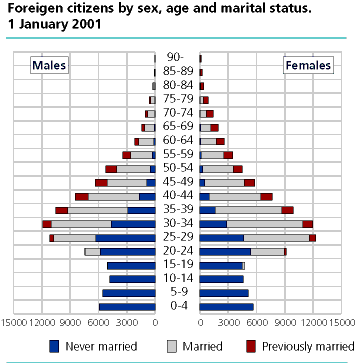Content
Published:
This is an archived release.
Iraqis outnumber Pakistanis
From 1976, the first year that statistics on foreign citizens were published, and every year until now Pakistani citizens have been the largest Asian group. In the course of 2000 the Iraqis took over.
After several years with many asylum seekers from Iraq the number of Iraqi citizens showed the biggest increase during 2000 with 4 100 persons, currently a total of 9 900 persons. The corresponding increase for 1999 was markedly lower (1 600 persons).
Approximately 6 700 Pakistani citizens lived in Norway at the turn of the year 2000/2001. On 1 January 2000 the number was 7 400, 700 more. Emigration and naturalizations both can account for some of this decrease; 1 100 Pakistanis were granted Norwegian citizenship in 2000.
Somewhat fewer European citizens
The number of European citizens was reduced by 200 persons compared to 1 January 2000. Still, as many as 64 per cent of the foreign citizens were Europeans. The Swedes top the list at 25 200, followed by Danish (19 400), Bosnian (11 600) and British citizens (11 100).
A number of Bosnians reached 7 years duration of stay in Norway in 2000 and were thereby able to apply for Norwegian citizenship. 900 Norwegian citizenships were granted to Bosnians in 2000, and it is realistic to assume that such a development will continue in the years to come as more persons fulfil the terms of application.
In addition to migration flows across the border, both births, deaths and naturalizations will affect the number of foreign citizens in Norway. Inhabitants with a foreign background can be either Norwegian or foreign citizens. The statistics on foreign citizens reflect a legal condition, while for example statistics on the immigrant population can be consulted for other information.
Tables:
- Table 1 Foreign citizens. Number and as a percentage of population. County. 1 January 1976-2001
- Table 2 Foreign citizens, by citizenship per 1 January 1975-2001
- Table 3 Foreigen citizen, by sex, age and citizenship. 1 January 2001
- Table 4 Foreigen citizens, by sex, marital status and citizenship. 1 January 2001
- Table 5 Foreigen citizen, by marital status, sex and age. 1 January 2001
- Table 6 Foreigen citizens, by sex, marital status, age and county. 1 January 2001
- Table 7 Foreigen citizens, by citizenship and county. 1 January 2001
- Table 8 Foreigen citizens, by citizenship. Selected municipalities. 1 January 2001
- Table 9 Foreign citizens by citizenship. Municipality. 1 January 2001
- Table 9.1 Østfold
- Table 9.2 Akershus and Oslo
- Table 9.3 Hedmark
- Table 9.4 Oppland
- Table 9.5 Buskerud
- Table 9.6 Vestfold
- Table 9.7 Telemark
- Table 9.8 Aust-Agder
- Table 9.9 Vest-Agder
- Table 9.10 Rogaland
- Table 9.11 Hordaland
- Table 9.12 Sogn og Fjordane
- Table 9.13 Møre og Romsdal
- Table 9.14 Sør-Trøndelag
- Table 9.15 Nord-Trøndelag
- Table 9.16 Nordland
- Table 9.17 Troms
- Table 9.18 Finnmark
The statistics is published with Population.
Contact
-
Statistics Norway's Information Centre
E-mail: informasjon@ssb.no
tel.: (+47) 21 09 46 42

